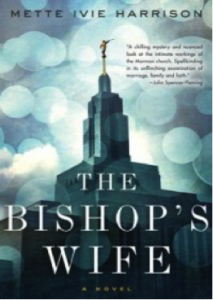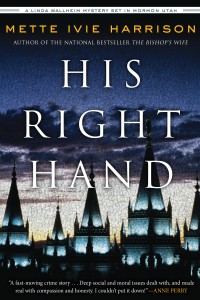Review
======
Title: The Bishop’s Wife
Title: His Right Hand
Author: Mette Ivie Harrison
Publisher: Soho Press (Crime)
Genre: Crime Novel Series
Years of Publication: 2014 and 2015
Number of Pages: 345 and 345
Binding: Hardcover
The Bishop’s Wife: ISBN13 978-1-61695-476-5
Price: $15.95
His Right Hand: ISBN 978-1-61695-610-3
Price: $26.95
Reviewed by Julie J. Nichols for the Association for Mormon Letters
The finalists for the AML Awards for 2016 in the novel and short fiction (as well as other genres at other sites) have been announced at https://www.associationmormonletters.org/2016/02/2015-aml-awards-finalists-2-novel-and-short-fiction/ . One of these, Mette Ivie Harrison’s *His Right Hand,* was published in 2015 by Soho Crime, a New York house whose titles “run the entire range of crime fiction,” promising across the board “an immersive adventure steeped in cultural and setting detail” (see http://sohopress.com/soho-crime/ ).
In 2014 Soho published Harrison’s *The Bishop’s Wife*—the forerunner to *His Right Hand*– because of the quality of the writing, the nature of the puzzle—sympathetic from the beginning—as well as the timely issues raised and the shocking solution to the mystery. But the clincher, Harrison tells us, was that the books’ setting is Draper, Utah. The cultural context is dyed-in-the-wool Mormonism. The protagonist, Linda Wallheimer, is neither private eye nor spy but an ordinary Mormon bishop’s wife. All these factors constitute what Soho acknowledged as a foreign world, in very fact. Foreign to the New York publishers; foreign to much of the world at large. It’s a fact we have to face.
Harrison, a nationally ranked triathlete with a Ph.D. from Princeton, is the author of eight YA novels and a regular blog on faith and Mormonism at The Huffington Post. Links to intelligent, readable posts, essays, and interviews can be found at http://metteivieharrison.com/mormonpage.html . This material–all of which I wanted to read, all of which I found appealing–describes the journey of this “Mormon in progress” through atheism back to thoughtful activity in the Church. She says that during her years of atheism, she observed the Church as if through an anthropologist’s eyes, so that there’s a neutrality to her commentary that many find refreshing and helpful. This background—this neutrality—help make the Linda Wallheimer mysteries the success that they indubitably are.
The question of how to present the Utah Mormon mindset is a fundamental one for regional LDS writers. LDS writers from outside Utah are every bit as acquainted with the fine line between telling too much and taking too much for granted about what readers know concerning the background beliefs and cultural strictures of Mormonism. But that line is particularly tricky to navigate when the setting is Utah itself, where Mormonism is the background music of much that happens, from liquor laws to Sunday mall closings to newspaper reportage (and on and on and on). Here, levels of education, differences in attitude and experience, family expectations (or not) and personal responses to public policy and custom comprise a complicated weave of acceptance and protest, compassion and judgment, outreach and bitter ostracism.
So Harrison’s “anthropological” stance, in the Linda Wallheimer novels, affords her a unique take. I’m not sure I believe in the complex mix of obedience-and-kindness and independence-and-rebellion that is Linda Wallheim. But Harrison gives her protagonist smart responses to what happens in her world. Admirable ones. The best we might hope for in the rare and unusual setting of murder within ward boundaries, murder whose motives have everything to do with Mormonism’s worst extremes.
 *The Bishop’s Wife* introduces the concept of the ward, with its customs predicated on and in Mormon hierarchy (“Mormon bishop’s wife isn’t an official calling…there’s no ceremonial laying-on of hands or pronounced blessings…but there were five hundred people who were under my care” (1)) and the habits of neighborliness that bind the people (“Food is the first thing we Mormons tend to offer” (4)).
*The Bishop’s Wife* introduces the concept of the ward, with its customs predicated on and in Mormon hierarchy (“Mormon bishop’s wife isn’t an official calling…there’s no ceremonial laying-on of hands or pronounced blessings…but there were five hundred people who were under my care” (1)) and the habits of neighborliness that bind the people (“Food is the first thing we Mormons tend to offer” (4)).
When a young mother disappears, leaving her husband with a young child, Linda is privy to the bishop’s involvement (“Kurt had enormous faith in the power of prayer…though any marriage could be saved with enough work and help from God” (7)), but also positioned to see and make deductions from another vantage point (“I am sad to say I am not as believing…” (7)).
As the story unfolds, Harrison creates a fine balance between explaining Mormon “standards” and demonstrating real-life messiness. Subplots include Linda’s own children’s growing-up pains, ward weddings and deaths, the internal secrets of the missing woman’s family, and the unhealed grief Linda herself still feels over a lost child. Real-world issues that no Church policy can disguise or dissipate infuse the investigation. Linda is not naïve, but some of the people she works with seem to be. The age-old problem of trying to keep inescapable psychological damage secret is very alive in this novel—not a uniquely Mormon problem at all, but exacerbated by Mormon habits of thought and behavior.
 *His Right Hand* tackles similarly difficult issues to those in *The Bishop’s Wife.* This time, Linda’s husband’s counselor is found murdered in the ward house—a horrible scenario—which is made even worse when the autopsy reveals him to have been a biological female. Questions about gender and transgender, about male and female roles, about marriages based on lies and their effects on the children, beset every moment of this investigation. Harrison doesn’t sugar-coat the motives and methods of the villains in either novel. We are as shocked as Linda as we begin to discern who has done what to whom. It’s to Harrison’s great credit that she’s able to divide the strands that are strictly Mormon in cause from those that are more universally human. But she also shows how impossible it is to keep one’s Mormonism separate from one’s humanness. Life is messy. Being a Mormon does not make anyone immune to its horrors.
*His Right Hand* tackles similarly difficult issues to those in *The Bishop’s Wife.* This time, Linda’s husband’s counselor is found murdered in the ward house—a horrible scenario—which is made even worse when the autopsy reveals him to have been a biological female. Questions about gender and transgender, about male and female roles, about marriages based on lies and their effects on the children, beset every moment of this investigation. Harrison doesn’t sugar-coat the motives and methods of the villains in either novel. We are as shocked as Linda as we begin to discern who has done what to whom. It’s to Harrison’s great credit that she’s able to divide the strands that are strictly Mormon in cause from those that are more universally human. But she also shows how impossible it is to keep one’s Mormonism separate from one’s humanness. Life is messy. Being a Mormon does not make anyone immune to its horrors.
For those of us who resolve contradictions between Mormon efforts at perfection and the realities of life differently than Linda, her bishop husband, and the people in their ward, the “neutrality” of the point of view in *The Bishop’s Wife* can render Mormonism troubling. Does Mormonism really require its adherents to be so rigid? So unthinking? So detached from the complexities of twenty-first century American life? Must it be that way? Is it only in Utah that it seems to be so—are Arkansas Mormons similarly blind? What about other sects—are Southern Baptists like this too? Honestly: does the Savior we worship want blind, detached, rigid followers? I can’t imagine it.
No wonder a Milwaukee Journal Sentinel reviewer declared that *The Bishop’s Wife* was “so far from my reality I needed a telescope.” Or that Publishers Weekly lauded Harrison’s ability to evoke “a world most will find as unfamiliar as a foreign country.” I will be interested to see how many mysteries Linda will have to solve as bishop’s wife—what will happen when her husband is released? Will she then be the wife of a high councilor, a stake president, a senior missionary?
In any case, both the current Linda Wallheimer novels are worth reading, and not only for their uncompromising plot lines and compelling conclusions. They should raise important and necessary questions about Mormonism itself in every thinking Mormon’s mind. *His Right Hand* deserves its nomination for an AML Award. I’ll watch eagerly for the final result.
